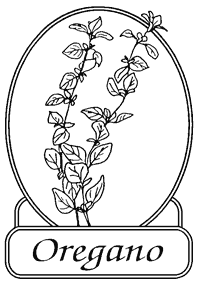By Steven Horne and Paula Perretty
 An essential component of Greek and Italian-American cuisines, oregano is native to Europe, the Mediterranean and parts of Asia. It is often found in tomato sauces, fried vegetables and grilled meat, where it has an aromatic, warm and slightly bitter taste. Like other members of the mint family, it’s aromatic qualities make it useful both as a spice and as a medicinal herb.
An essential component of Greek and Italian-American cuisines, oregano is native to Europe, the Mediterranean and parts of Asia. It is often found in tomato sauces, fried vegetables and grilled meat, where it has an aromatic, warm and slightly bitter taste. Like other members of the mint family, it’s aromatic qualities make it useful both as a spice and as a medicinal herb.
The leaves of various species of oregano (Origanum genus) have been traditionally used for respiratory and digestive system ailments, and as an antiseptic for fighting infection. These uses date back to the famous Greek physician Hippocrates.
Medicinally, oregano is categorized primarily as an antispasmodic, carminative, diaphoretic, emmenagogue, expectorant, stimulant and stomachic. Traditionally taken in tea form, oregano has been used to treat colds, flu, fevers, indigestion, gas and bloating and painful menstruation. It is also a mild sedative and can be used to promote sleep.
In modern times oregano has come to be used primarily for its antiseptic, antifungal and antiparasitic properties. Most of this activity comes from oregano’s volatile oils. Up to 90% of the essential oil is made up of thymol, carvacrol, limonene, pinene, ocimene, caryophyllene and other terpinenes that have strong antimicrobial and antiparasitic action.
Because it is both antiseptic and expectorant, oregano is helpful for respiratory infections. This is why it is an important component of NSP’s Seasonal Defense Formula.
The most popular modern use of oregano is in fighting yeast and fungal infections. The oil of oregano has been shown to have anti-fungal properties 100 times more potent than caprylic acid against Candida, mainly due to the presence of carvacrol.
A study conducted at a University in Turkey measured the antifungal activities of four herbs—sage, wild thyme, oregano and savory—against six mold species. The results showed that sage had weak activity, while wild thyme, oregano and savory were active against all molds tested. All test fungi were completely inhibited by oregano.
A study done at the Department of Plant Physiology in Belgrade also confirmed the antifungal activity of oregano. Researchers compared the antifungal activity of a variety of essential oils against thirteen different fungal species. The essential oil of oregano showing he highest and broadest antifungal activity
Another study at Michigan State University confirmed the antifungal properties of the carvacrol found in oregano oil against toenail fungus. The Department of Pharmacology at the University of Athens also found carvacrol was effective against six species of gram-negative and gram-positive bacteria, and three species of pathogenic fungi.
The bottom line is that there is ample scientific evidence to back up the use of oregano for yeast and fungal infections as well as bacterial infections. This is why the herb is a major ingredient in NSP’s Yeast/Fungal Detox.
NSP also offers the essential oil of Wild Oregano. This is a much more potent medicine than the oregano herb found in your kitchen spice cabinet. The terpenes in oregano oil are hepatotoxic, so the essential oil should be used primarily for topical applications. It can be diluted with a carrier oil and massaged into the skin, diffused for inhalation or used in baths and soaks for treating both bacterial and fungal infections.
Many people use the essential oil internally for yeast and fungal infections. We do not recommend this practice. There are other very good antifungal essential oils that are much safer for internal use, such as thyme and lavender oil.
Pregnant women should avoid the use of oregano oil because it may be a uterine stimulant. Breast-feeding women should also avoid it because it can decrease milk supply.
Selected References
- Antifungal properties of some herb decoctions by M. Özcan, N. Boyraz, in Journal European Food Research and Technology.

